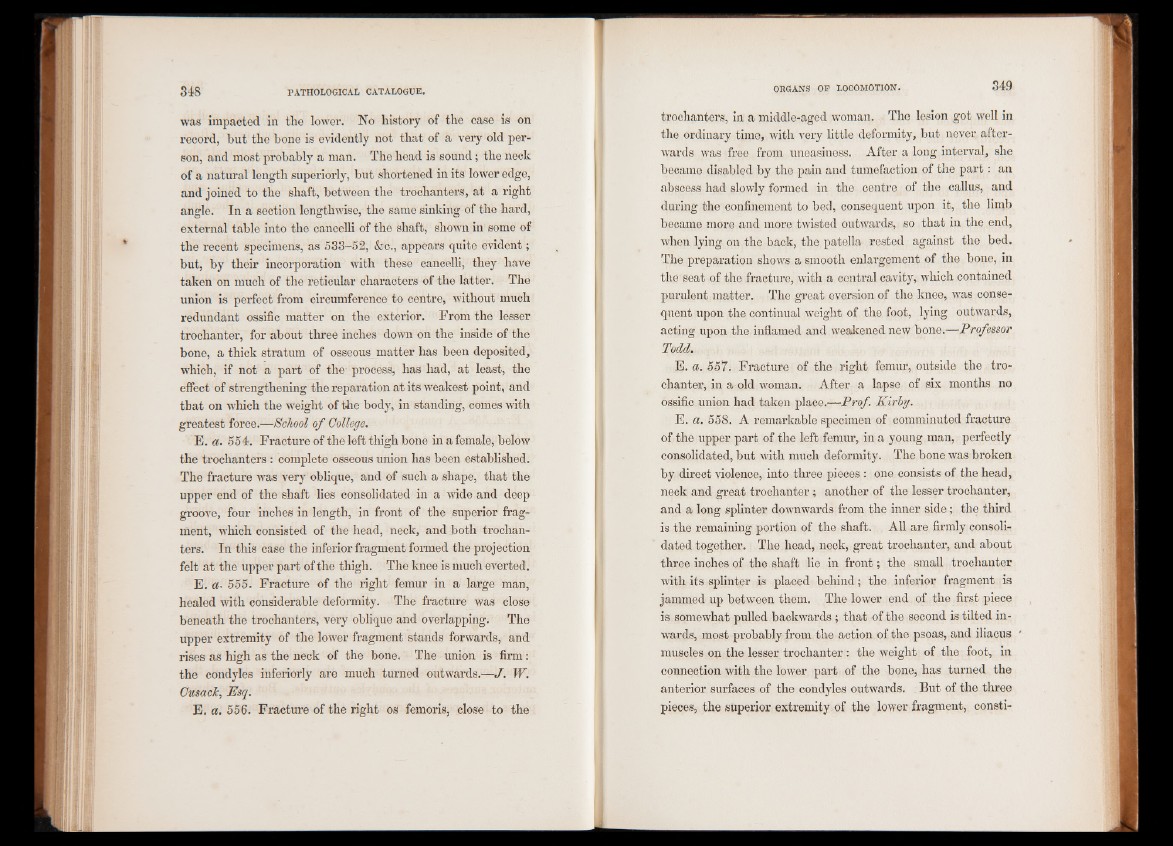
was impacted in the lower. No history of the case is on
record, but the bone is evidently not that of a very old person,
and most probably a man. The head is sound; the neck
of a natural length superiorly, but shortened in its lower edge,
and joined to the shaft, between the trochanters, at a right
angle. In a section lengthwise, the same sinking of the hard,
external table into the cancelli of the shaft, shown in some of
the recent specimens, as 533-52, &c., appears quite evident;
but, by their incorporation with these cancelli, they have
taken on much of the reticular characters of the latter. The
union is perfect from circumference to centre, without much
redundant ossific matter on the exterior. From the lesser
trochanter, for about three inches down on the inside of the
bone, a thick stratum of osseous matter has been deposited,
which, if not a part of the process, has had, at least, the
effect of strengthening the reparation at its weakest point, and
that on which the weight of the body, in standing, comes with
greatest force.—School of College.
E. a. 554. Fracture of the left thigh bone in a female, below
the trochanters : complete osseous union has been established.
The fracture was very oblique, and of such a shape, that the
upper end of the shaft lies consolidated in a wide and deep
groove, four inches in length, in front of the superior fragment,
which consisted of the head, neck, and both trochanters.
In this case the inferior fragment formed the projection
felt at the upper part of the thigh. The knee is much everted.
E. a. 555. Fracture of the right femur in a large man,
healed with considerable deformity. The fracture was close
beneath the trochanters, very oblique and overlapping. The
upper extremity of the lower fragment stands forwards, and
rises as high as the neck of the bone. The union is firm:
the condyles inferiorly are much turned outwards.—J. W.
Cusack, Esq.
E. a. 556. Fracture of the right os femoris, close to the
trochanters, in a middle-aged woman. The lesion got well in
the ordinary time, with very little deformity, but never afterwards
was free from uneasiness. After a long interval, she
became disabled by the pain and tumefaction of the part: an
abscess had slowly formed in the centre of the callus, and
during the confinement to bed, consequent upon it, the limb
became more and more twisted outwards, so that in the end,
when lying on the back, the patella rested against the bed.
The preparation shows a smooth enlargement of the bone, in
the seat of the fracture, with a central cavity, which contained
purulent matter. The great eversion of the knee, was consequent
upon the continual weight of the foot, lying outwards,
acting upon the inflamed and weakened new bone.—Professor
Todd.
E. a. 557. Fracture of the right femur, outside the trochanter,
in a old woman. After a lapse of six months no
ossific union had taken place.—Prof. Kirby.
E. a. 558. A remarkable specimen of comminuted fracture
of the upper part of the left femur, in a young man, perfectly
consolidated, but with much deformity. The bone was broken
by direct violence, into three pieces : one consists of the head,
neck and great trochanter ; another of the lesser trochanter,
and a long splinter downwards from the inner side; the third
is the remaining portion of the shaft. All are firmly consolidated
together. The head, neck, great trochanter, and about
three inches of the shaft lie in front; the small trochanter
with its splinter is placed behind; the inferior fragment is
jammed up between them. The lower end of the first piece
is somewhat pulled backwards ; that of the second is tilted inwards,
most probably from the action of the psoas, and iliacus
muscles on the lesser trochanter : the weight of the foot, in
connection with the lower part of the bone, has turned the
anterior surfaces of the condyles outwards. But of the three
pieces, the superior extremity of the lower fragment, consti